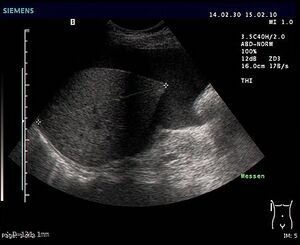Abdominal puncture (paediatrics)
(Redirected from Abdominal puncture (pediatrics))
Indications and technique[edit | edit source]
- Abdominal puncture is performed in acutely or chronically ill children with ascites, for diagnostic or therapeutic reasons;
- Removal of a larger amount of fluid is important to relieve the pressure of ascites on the diaphragm in respiratory distress or the pressure on the renal veins in oligoanuria;
- Adequate analgosedation is essential;
- The patient is in a supine position, the upper part of the body is elevated by 30 degrees;
- The bladder must be empty (the child urinates or defecates);
- The procedure is performed under sterile conditions, using local anesthesia with 1% mesocaine;the injection site is at 1/3 of the junction between the umbilicus and spina iliaca anterior superior or at 1/3 of the distance between the umbilicus and the symphysis;
- An intravenous cannula (size G 22 to 18) with an attached syringe is inserted through the abdominal wall under a slight negative pressure, when passing through the peritoneum we feel a sudden loss of resistance; then we only insert the cannula and pull out the needle;
- In order to prevent hemodynamic instability in a patient with massive ascites, we evacuate from the peritoneal cavity only the amount necessary for the examination of ascites;
- during therapeutic puncture, we withdraw the fluid slowly and in the case of hemodynamic instability, we also add the colloid volume;
- with this method, a peritoneal catheter in a patient with renal failure or a catheter for peritoneal lavage in patients after injury can be introduced into the peritoneal cavity.
Complications[edit | edit source]
Perforation of the intestine usually remains without consequences, because the hole after the injection closes soon. Vessel perforation can occur intraperitoneally or extraperitoneally. The opening usually also closes quickly, but a hematoma may form . Bacterial contamination of the peritoneal cavity occurs when the rules of asepsis are not followed or contamination from an intestinal perforation that does not close. Rapid removal of a large amount of ascitic fluid with subsequent transfer of intracellular fluid to the extracellular space can induce hypotension.
Examination of the peritoneal fluid[edit | edit source]
The peritoneal fluid is examined for the number of erythrocytes , leukocytes , including the differential budget, biochemical parameters ( glucose , total protein, fibrinogen , amylase , ammonia ), cytologically, microscopically ( Gram staining ), cultured.
Peritoneal fluid is clear to straw yellow. Turbidity is common in chemical or infectious peritonitis , milky or white-yellow liquid in chylous ascites. The green coloring is due to perforation of the gallbladder or choledoch, or inflammation of the peritoneum as a result of pancreatitis . Blood staining indicates a traumatic puncture or laceration of an abdominal organ.
The number of leukocytes > 500/mm 3 with a predominance of polymorphonuclear leukocytes in the differential is in bacterial peritonitis. In chylous ascites or TB peritonitis, lymphocytes predominate in the differential picture . Tumor cells can be demonstrated in ascites associated with tumors. Glucose level < 3.33 mmol/l or < 2/3 glycemia is in tumors or bacterial peritonitis.
Characteristics of transudate and exudate[edit | edit source]
- Transudate
- Protein < 25 g/l,
- Ascites protein/serum protein ratio < 0.5,
- Fibrinogen 0.3-0.5% of total proteins,
- Specific gravity < 1015 g/l.
- Exudate
- Protein > 25 g/l,
- Ascites protein/serum protein ratio > 0.5,
- Specific gravity > 1015 g/l.
ALP levels are > 2x elevated compared to normal serum levels in patients with necrotic or perforated colon.
Ammonia level is increased more than 2x in patients with intestinal strangulation or perforated duodenal ulcer.
In diseases of the uropoietic system, ascitic fluid has an increased content of ammonia, creatinine and potassium. The level of amylase is higher than in serum in pancreatitis, pancreatic pseudocyst, perforation or strangulation of the intestine.
Links[edit | edit source]
Source[edit | edit source]
- HAVRÁNEK, Jiří: Abdominal puncture . (edited)

